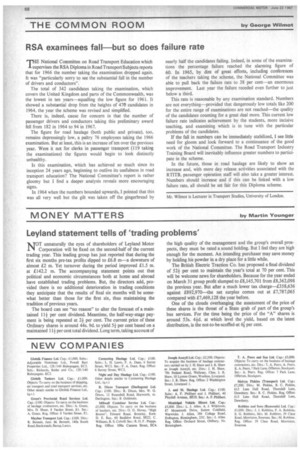RSA examinees fall—but so does failure rate
Page 70

If you've noticed an error in this article please click here to report it so we can fix it.
THE National Committee on Road Transport Education which -Isupervises the RSA Diploma in Road Transport Subjects reports that for 1966 the number taking the examination dropped again. It was "particularly sorry to see the substantial fall in the number of drivers and conductors".
The total of 342 candidates taking the examination, which covers the United Kingdom and parts of the Commonwealth, was the lowest in ten years—equalling the low figure for 1961. It showed a substantial drop from the heights of 476 candidates in 1964, the year the scheme was revised and simplified.
There is, indeed, cause for concern in that the number of passenger drivers and conductors taking this preliminary award fell from 182 in 1964 to 94 in 1967.
The figure for road haulage (both public and private), too, remains depressingly low, a paltry 76 employees taking the 1966
examination. But at least, this is an increase of ten over the previous year. Were it not for clerks in passenger transport (119 taking the examinations) the figures would begin to look distinctly unhealthy.
Is this examination, which has achieved so much since its inception 24 years ago, beginning to outlive its usefulness in road transport education? The National Committee's report is rather gloomy but I find a deeper analysis reveals more encouraging signs.
In 1964 when the numbers bounded upwards, I pointed that this was all very well but the gilt was taken off the gingerbread by
nearly half the candidates failing. Indeed, in some of the examinations the percentage failure reached the alarming figure of 60. In 1965, by dint of great efforts, including conferences of the teachers taking the scheme, the National Committee was able to pull back the failure rate to 38 per cent—an enormous improvement. Last year the failure receded even further to just below a third.
This rate is reasonable by any examination standard. Numbers are not everything—provided that dangerously low totals like 200 for the entire range of examinations are not reached—the quality of the candidates counting for a great deal more. This current low failure rate indicates achievement by the students, more incisive teaching, and examining which is in tune with the particular problems of the candidates.
If the fall in numbers can be immediately stabilized, I see little need for gloom and look forward to a continuance of the good work of the National Committee. The Road Transport Industry Training Board will inevitably influence greater numbers to participate in the scheme.
In the future, those in road haulage are likely to show an increase and, with more day release activities associated with the RTITB, passenger operation staff will also take a greater interest. Numbers should increase and if this can be linked with a low failure rate, all should be set fair for this Diploma scheme.
Mr. Wilmot is Lecturer in Transport Studies, University of London.












































































































